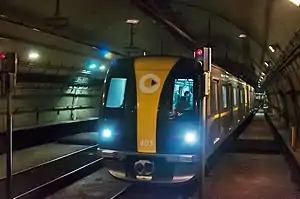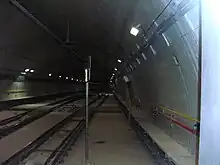São Paulo Metro Hyundai Rotem stock
The São Paulo Metro Hyundai Rotem stock is a class of electric multiple units built by Hyundai Rotem between 2008 and 2017, operated by ViaQuatro, responsible for Line 4-Yellow.[1]
| Hyundai Rotem stock | |
|---|---|
 | |
 | |
| In service | 2010–present |
| Manufacturer | Hyundai Rotem |
| Built at | |
| Constructed |
|
| Entered service | 25 May 2010 |
| Number built | 29 sets |
| Number in service | 29 sets |
| Formation | 6-car sets (A–B–B–B–B–A) |
| Fleet numbers | 4011–4296 |
| Capacity | 1,946 (if 6 passengers/m²) |
| Operator(s) | ViaQuatro |
| Depot(s) | Vila Sônia Yard |
| Line(s) served | |
| Specifications | |
| Car body construction | Stainless steel |
| Train length | 128.5 m (421 ft 7 in) |
| Width | 2.8 m (9 ft 2 in) |
| Entry | Level |
| Doors | 8 sets of side doors per car |
| Wheel diameter | 860–780 mm (34–31 in) (new–worn) |
| Wheelbase | 2,300 mm (7 ft 7 in) |
| Maximum speed | 80 km/h (50 mph) |
| Traction system | VVVF |
| Traction motors | 24 × 180 kW (240 hp) asynchronous 3-phase AC |
| Power output | 4,320 kW (5,790 hp) |
| HVAC | Carrier Global air conditioning 276 kW (370 hp) |
| Electric system(s) | 1,500 V DC overhead line |
| Current collector(s) | Stemmann-Technik pantograph FB800.18 |
| UIC classification | Bo′Bo′+Bo′Bo′+Bo′Bo′+Bo′Bo′+Bo′Bo′+Bo′Bo′ |
| Braking system(s) | Knorr-Bremse friction |
| Safety system(s) | Siemens Trainguard MT CBTC |
| Track gauge | 1,435 mm (4 ft 8+1⁄2 in) standard gauge |
History and features

The consortium winner of the Line 4 concession was ViaQuatro, who had to obey the public-private partnership bid that projected the trains must have standard gauge, instead of broad gauge present on Lines 1, 2 and 3 and overhead lines like on Line 5 and CPTM lines. The voltage is of 1,500 V. In March 2010, 5 of the 14 initial units were already in tests on the line.[2]
The compositions, built in South Korea, have the driverless system, the first in Latin America, which allows the operation of the train without a driver.[3] The cars are all interconnected by articulated corridors and also have air conditioning system. Initially, it was estimated that they would have cell phone signal and wireless internet access,[3] but the Wi-Fi propposal was discarded and the cellular connection took months to be available on the line.
The trains have emergency exits on the front and back of the compositions,[3] where the front mask bends down, opening the way and creating a ramp for passagers to disembark and walk on the tracks until the next station. Also because of that, the space between tracks was unobstructed, to avoid accidents in case of evacuation. Besides that, there are side walkways on the tunnels between stations, just like other metro lines. Therefore, so the passengers in B cars can leave, they use the free gangway. In the A cars, there are 2 windows where passengers can have a view from the tracks, an angle not available in other lines of the system, with the exception of Line 15-Silver.
References
- "Nossa História". Hyundai Rotem Brasil (in Brazilian Portuguese). Retrieved 3 August 2023.
- "Linha 4-Amarela terá internet sem fio e música". Estadão (in Brazilian Portuguese). 17 March 2010. Archived from the original on 22 March 2010. Retrieved 4 August 2023.
- "Novos trens da Linha 4 - Amarela do Metrô de SP operarão sem condutor; veja imagens". UOL Notícias (in Brazilian Portuguese). 10 November 2009. Retrieved 4 August 2023.
External links
- ViaQuatro official website (in Portuguese)